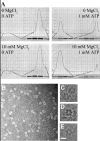The ATPase activity of BfpD is greatly enhanced by zinc and allosteric interactions with other Bfp proteins
- PMID: 15866879
- PMCID: PMC1224739
- DOI: 10.1074/jbc.M500253200
The ATPase activity of BfpD is greatly enhanced by zinc and allosteric interactions with other Bfp proteins
Retraction in
-
The ATPase activity of BfpD is greatly enhanced by zinc and allosteric interactions with other Bfp proteins.J Biol Chem. 2009 Jul 31;284(31):21100. doi: 10.1074/jbc.a500253200. J Biol Chem. 2009. PMID: 19785092 Free PMC article. No abstract available.
Abstract
Type IV pilus biogenesis, protein secretion, DNA transfer, and filamentous phage morphogenesis systems are thought to possess similar architectures and mechanisms. These multiprotein complexes include members of the PulE superfamily of putative NTPases that have extensive sequence similarity and probably similar functions as the energizers of macromolecular transport. We purified the PulE homologue BfpD of the enteropathogenic Escherichia coli bundle-forming pilus (BFP) biogenesis machine and characterized its ATPase activity, providing new insights into its mode of action. Numerous techniques revealed that BfpD forms hexamers in the presence of nucleotide. Hexameric BfpD displayed weak ATPase activity. We previously demonstrated that the N termini of membrane proteins BfpC and BfpE recruit BfpD to the cytoplasmic membrane. Here, we identified two BfpD-binding sites, BfpE(39-76) and BfpE(77-114), in the N terminus of BfpE using a yeast two-hybrid system. Isothermal titration calorimetry and protease sensitivity assays showed that hexameric BfpD-ATPgammaS binds to BfpE(77-114), whereas hexameric BfpD-ADP binds to BfpE(39-76). Interestingly, the N terminus of BfpC and BfpE(77-114) together increased the ATPase activity of hexameric BfpD over 1200-fold to a V(max) of 75.3 mumol of P(i) min(-1) mg(-1), which exceeds by over 1200-fold the activity of other PulE family members. This augmented activity occurred only in the presence of Zn(2+). We conclude that allosteric interactions between BfpD and BfpC and BfpE dramatically stimulate its ATPase activity. The differential nucleotide-dependent binding of hexameric BfpD to BfpE(39-76) and BfpE(77-114) suggests a model for the mechanism by which BfpD transduces mechanical energy to the biogenesis machine.
Figures








Similar articles
-
Structure of an essential type IV pilus biogenesis protein provides insights into pilus and type II secretion systems.J Mol Biol. 2012 May 25;419(1-2):110-24. doi: 10.1016/j.jmb.2012.02.041. Epub 2012 Mar 1. J Mol Biol. 2012. PMID: 22387466 Free PMC article.
-
The inner membrane subassembly of the enteropathogenic Escherichia coli bundle-forming pilus machine.Mol Microbiol. 2004 Apr;52(1):67-79. doi: 10.1111/j.1365-2958.2003.03963.x. Mol Microbiol. 2004. PMID: 15049811
-
Novel topology of BfpE, a cytoplasmic membrane protein required for type IV fimbrial biogenesis in enteropathogenic Escherichia coli.J Bacteriol. 2001 Aug;183(15):4435-50. doi: 10.1128/JB.183.15.4435-4450.2001. J Bacteriol. 2001. PMID: 11443077 Free PMC article.
-
The molecular chaperone, ClpA, has a single high affinity peptide binding site per hexamer.J Biol Chem. 2005 Apr 1;280(13):12221-30. doi: 10.1074/jbc.M411733200. Epub 2005 Jan 18. J Biol Chem. 2005. PMID: 15657062
-
Structure-function relationships in an anion-translocating ATPase.Biochem Soc Trans. 2000;28(4):520-6. Biochem Soc Trans. 2000. PMID: 10961952 Review.
Cited by
-
Membrane association and multimerization of TcpT, the cognate ATPase ortholog of the Vibrio cholerae toxin-coregulated-pilus biogenesis apparatus.J Bacteriol. 2007 Jun;189(12):4401-9. doi: 10.1128/JB.00008-07. Epub 2007 Apr 13. J Bacteriol. 2007. PMID: 17434972 Free PMC article.
-
The dimer formed by the periplasmic domain of EpsL from the Type 2 Secretion System of Vibrio parahaemolyticus.J Struct Biol. 2009 Nov;168(2):313-22. doi: 10.1016/j.jsb.2009.07.022. Epub 2009 Jul 29. J Struct Biol. 2009. PMID: 19646531 Free PMC article.
-
Yeast two-hybrid and itc studies of alpha and beta spectrin interaction at the tetramerization site.Cell Mol Biol Lett. 2011 Sep;16(3):452-61. doi: 10.2478/s11658-011-0017-9. Epub 2011 Jul 18. Cell Mol Biol Lett. 2011. PMID: 21786033 Free PMC article.
-
Hexameric structures of the archaeal secretion ATPase GspE and implications for a universal secretion mechanism.EMBO J. 2007 Feb 7;26(3):878-90. doi: 10.1038/sj.emboj.7601544. Epub 2007 Jan 25. EMBO J. 2007. PMID: 17255937 Free PMC article.
-
Identification and characterization of a unique, zinc-containing transport ATPase essential for natural transformation in Thermus thermophilus HB27.Extremophiles. 2011 Mar;15(2):191-202. doi: 10.1007/s00792-010-0343-2. Epub 2011 Jan 6. Extremophiles. 2011. PMID: 21210168
References
Publication types
MeSH terms
Substances
Grants and funding
LinkOut - more resources
Full Text Sources
Molecular Biology Databases
Research Materials
Miscellaneous

